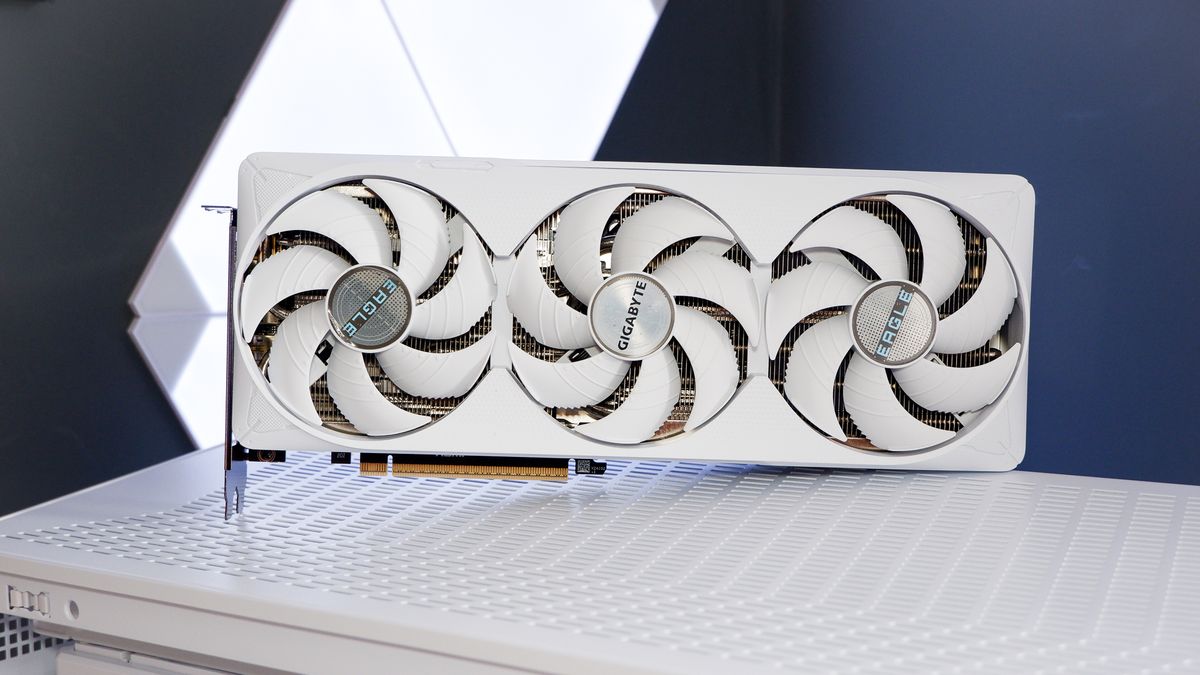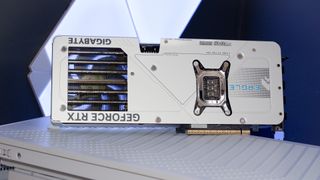
I’ve been looking around the past few days for the RTX 5070 Ti, and to my surprise, you can find this graphics card on the shelves and ready to buy. That might not be the glowing review it sounds like, as this card left a lot to be desired in our first experiences with it and likely for its high third-party pricing. If you’d still like to learn more, or you’re planning a white PC build in the near future, then this review is for you, if only so you can make your mind up whether to buy this card, or sensibly try to find an RX 9070 XT close to MSRP instead.
Alright, with that out of the way, let’s turn our attention to the card at hand, the Gigabyte GeForce RTX 5070 Ti Eagle OC Ice SFF.
This is a triple-fan card with three ‘Hawk’ fans. The middle of the three spins in reverse, which is not an uncommon approach these days to help ease temperatures. The backplate comes in a clean-cut silver finish, though the card is predominantly white, hence the ‘Ice’ nomenclature. There’s a cut-out on the far side to allow a little room for the heatsink to breathe and it does expel some rather toasty air in operation. You’ll want some case fans blowing its way to shift any residual hot air away from your CPU and out of the case.
The card measures 304 x 126 x 50 mm. That earns it the title of ‘Nvidia SFF-ready’ and means it’s good for a small form factor case. Though the definitions of small are being tested to their absolute limit with most ‘SFF-ready’ cards these days. This unit still demands over two PCIe slots and is a touch wider than the MSI GeForce RTX 5080 Ventus 3X OC White I’ve been testing around the same time. It also weighs a good chunk at 1223 g (2.69 lbs), heavier than the Ventus 3X, though there’s a support included in the box to help prevent droop.
Eagle OC Ice specs
The Eagle OC is an otherwise sleek-looking graphics card. It has a surprisingly tasteful RGB LED strip along the bottom length of the card, which can be controlled via Gigabyte’s Control Center software. I also tried to adjust the light bar through OpenRGB, however, this specific Gigabyte card is not yet supported. The Gigabyte Control Center package is quite a large download at just over 800 MB and I was hoping to not have to keep it around. Though, in its defence, it also offers fan profiles for the Eagle OC, and lets you set or find a suitable overclock. I ended up sticking with MSI Afterburner—if it ain’t broke—but you could save on another download here.
Lastly, on the card there’s a small switch to change between the Performance and Silent vBIOS profiles. All my testing below is done on the Performance profile as this isn’t a loud graphics card to begin with. However, if you must drop it to Silent, I ran a few tests and found it generally ran more or less the same as Performance mode in terms of clock speed and power draw. It was consistently slower, however, and since it’s not actually silent, I’m not sure it’s worth the hassle. I didn’t really notice much of a dip in noise levels whatsoever. It’s good to have a backup vBIOS should in the unlikely event anything go wrong, at least.
The only way to unearth the innards of this card is to entirely remove the heatsink from the GPU and memory, so that’s what I’ve done. Gigabyte has actually used a thermal putty on the memory and VRM here and has been quite generous with the dollop for each component. It all appears to make good coverage and there’s not a spot missing, though it doesn’t appear there’s much pressure on the inductors to spread the putty out completely.

I’ve found this card listed over at Best Buy for $900. Not available, of course. To put that into perspective, the MSRP of the RTX 5070 Ti is $749, meaning this card is $151 over the usual asking price. There is no Founders Edition RTX 5070 Ti, and my attempts to try to find an MSRP RTX 5070 Ti at launch are well documented, so make of that MSRP what you will. To put it at a slightly different perspective again, this Eagle OC Ice is one of the more affordable third-party RTX 5070 Ti cards going.
You see the problem here? The RTX 5070 Ti, generally, is anything but affordable and made worse by extreme third-party prices. The Eagle OC Ice isn’t the worst of the lot for that, but it’s far from well-priced. To distill that down into one cohesive thought, however you look at it, the Eagle OC Ice is a tough sell.
But I’m yet to share the performance figures, which might help you make up your own mind. The ‘OC’ in this card’s title means this card is a little juiced up versus the stated reference figure, and thus runs at 2542 MHz boost to the nominal 2452 MHz—a 90 MHz increase.
We’ve so far tested five overclocked RTX 5070 Ti cards, and I can say that across those cards any and all variation in boost clock has resulted in the square root of nothing. A frame or two separate the lot in most games, if they perform any differently whatsoever. Only our Homeworld 3 results are out of whack with that analysis, but this game is quite CPU-bound and the slight increase in performance seems consistent with a tiny and mysterious improvement in CPU performance, rather than GPU.
Most of the cards we’ve tested are more expensive than the Eagle Ice OC, including the MSI Gaming Trio and TUF Gaming OC. However, we have tested one nominally MSRP model, the Ventus 3X, which comes with a moderate factory overclock of 2,482 MHz as standard—just 60 MHz slower than the Eagle OC.

Excluding our results for Homeworld 3, the Eagle OC Ice is 0.43% faster than the Ventus 3X at 1080p, or 0.37% at 4K. Less than a percentile point difference for… $151 more.
Well, you clearly get more overclocking potential for that extra money, right? Unfortunately, no, not really. While it’s true that the RTX 50-series does overclock extremely well, I couldn’t get the Eagle OC Ice to match our +450 MHz offset overclock on the Ventus 3X. I had to settle for +440 MHz, which has remained stable throughout further testing. The difference between these overclocks is nothing in the grand scheme of things. Both cards perform near enough the same and these two samples are not indicative of the overclocks that might be possible on other cards even of the same design. Yet it’s a bit frustrating considering the fairly unexplainable price difference between them.
PC Gamer test platform
Supplied by Cyberpower | MSI
CPU: AMD Ryzen 7 9800X3D | Motherboard: MSI MPG X870E Edge Ti WiFi | RAM: Kingston Fury Beast RGB 32 GB (2 x 16 GB) @ 6,000 MT/s | Cooler: MAG CoreLiquid i360 White | SSD: Spatium M480 Pro 2 TB | PSU: MPG A1000GS PCIe 5 | Case: MAG Pano 100R White
One likely reason for the Gigabyte’s slimmer improvement is that it has a locked power limit at 100%, which means you’re working with the card’s existing power limit to find a suitable overclock. As such, if you’re a judicious overclocker looking to eke more out of the surprisingly fruitful RTX 50-series, look elsewhere.
There’s also the argument for AMD’s RX 9070 XT. I’ve included two for comparison here, the MSRP Asus Prime OC and $650 XFX Swift OC. The former is much more appealing than the latter, though demand has seen that prices have soared for AMD’s cards too. Nonetheless, as shown in the benchmark results, these Radeon cards are both competitive and draw attention away from Nvidia’s RTX 5070 Ti.
Buy if…
✅ You have cash to burn and will pay over the odds for an RTX 5070 Ti: Okay, it’s not that convincing, but if you are willing to spend $900+ on an RTX 5070 Ti, this one is at least bang on that amount, rather than creeping up into four-digit figures.
Don’t buy if…
❌ You want the best value for money: There’s nothing good about the performance-per-dollar ratio on this card. If you can find an MSRP or AMD alternative at a good price, that’s the one to go for.
❌ You want overclocking controls: There’s little tweaking to be had on the Eagle OC Ice.
In the Eagle OC Ice’s defence, it runs fairly cool. Not more so than most similar designs but at 64°C on average during Metro Exodus, it’s hardly toasty. Power draw is in a similar stasis, somewhere between average and bang-average.
What can I make of the whole thing? I’d like for this review to be useful in six months time, when there are heaps of MSRP or near-MSRP cards available. If the Eagle OC Ice dropped in price to a little over MSRP, you might excuse its middle-of-the-pack performance. However, I’m not convinced we’ll see such a massive correction from the manufacturer-set price in the short or medium-term, and I have to judge this card on where it stands today.
I just can’t really recommend this card. The RGB lighting is neat, and the white and silver colourway is one of my favourites of the 50-series family right now, but it’s all let down by that important performance-per-dollar. Since there’s no Founders Edition RTX 5070 Ti, it’s going up against mostly overpriced competition, and often more so than itself, but I’m not convinced there’s anywhere near enough here to justify that extra spend. There is also the RX 9070 XT, which performs similarly in a range of our tests, and theoretically available for a lower price still than the RTX 5070 Ti. Though, again, AMD’s card is subject to hiked up prices.
Altogether it’s tough to suggest a viable alternative for much less, though your time might be better spent chasing stock of a cheaper Radeon card.


